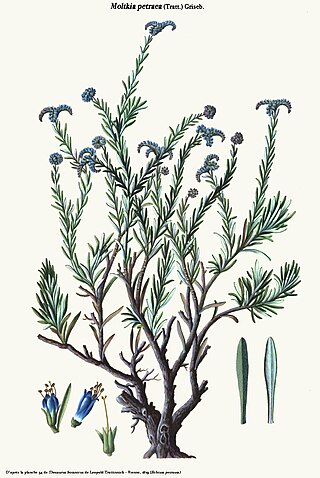
Royal Botanic Gardens, Kew is a non-departmental public body in the United Kingdom sponsored by the Department for Environment, Food and Rural Affairs. An internationally important botanical research and education institution, it employs 1,100 staff. Its board of trustees is chaired by Dame Amelia Fawcett.

The Salsoloideae are a subfamily of the Amaranthaceae, formerly in family Chenopodiaceae.

Chenopodium is a genus of numerous species of perennial or annual herbaceous flowering plants known as the goosefoot, which occur almost anywhere in the world. It is placed in the family Amaranthaceae in the APG II system; older classification systems, notably the widely used Cronquist system, separate it and its relatives as Chenopodiaceae, but this leaves the rest of the Amaranthaceae polyphyletic. However, among the Amaranthaceae, the genus Chenopodium is the namesake member of the subfamily Chenopodioideae.

Portulacaria is a genus of succulent plant, classified in its own subfamily Portulacarioideae in the family Didiereaceae. It is indigenous to southern Africa.

Pfaffia is a genus of plants in the family Amaranthaceae.

Halothamnus lancifolius is a species of the plant genus Halothamnus, that belongs to the subfamily Salsoloideae within the family Amaranthaceae,. It occurs in Southwest Asia.

Dysphania is a genus of plants in the family Amaranthaceae. Species of the genus are found worldwide from the tropics and subtropics to warm-temperate regions.

Halimione is a plant genus from the subfamily Chenopodioideae of the family Amaranthaceae. It is a sister genus of Atriplex and is included in that genus by Plants of the World Online.

Moltkia is a genus in the family Boraginaceae with 6 accepted species. They are herby semi-bushes (shrubs) with dark green hairy leaves and hanging groups of tube-shaped flowers. The species occur in the south of Europe and western Asia, where they are sparely hardy.

Parrya is a genus of flowering plants in the family Brassicaceae, found in the arctic and subarctic biomes of the Northern Hemisphere, and in Central Asia. The center of diversity is the Tian Shan and Pamir-Alay mountain ranges.

Achyropsis is a genus of plants in the amaranth family Amaranthaceae, found in Africa from Kenya to South Africa.
Allmaniopsis fruticulosa is a species of flowering plant belonging to the family Amaranthaceae. It is the sole species in genus Allmaniopsis. It is a subshrub endemic to eastern Kenya.

Anthochlamys is a genus of flowering plants belonging to the family Amaranthaceae.
Archanthemis is a genus of flowering plants belonging to the family Asteraceae.

Matthiola fruticulosa, the sad stock or dark-flowered stock, is a species of flowering plant in the family Brassicaceae, native to the Mediterranean region. It is adapted to clay and marl soil types.

Manochlamys albicans is a species of flowering plant belonging to the family Amaranthaceae. It is the sole species in genus Manochlamys. It is a subshrub or shrub native to Namibia and the Cape Provinces of South Africa.
Pycnocycla is a genus of flowering plants belonging to the family Apiaceae.

Exomis is a genus of flowering plants belonging to the family Amaranthaceae. It just contains one species, Exomis microphylla(Thunb.) Aellen It is also in the Chenopodioideae subfamily.
Salix fruticulosa is a species of flowering plant in the willow family Salicaceae, native to Nepal, the eastern Himalayas, and Tibet. It is common in sub-alpine silver fir–birch forests from 2,800 to 3,800 m. Although there may some confusion about which species of dwarf willow is intended, Salix fruticulosa is listed by the Royal Horticultural Society as available from commercial suppliers.

Hedyotis scabridifolia is an herb or small shrub that is endemic to the volcanic soils of the Mariana Islands of Guam, Rota and Saipan.















